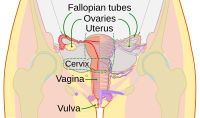
Photo from wikipedia
BackgroundA randomized prospective trial to compare the effects on minimizing complications using continuous negative pressure drain and intermittent suction mode in plastic surgeries.MethodsThere were 174 cases of stage II post-auricular… Click to show full abstract
BackgroundA randomized prospective trial to compare the effects on minimizing complications using continuous negative pressure drain and intermittent suction mode in plastic surgeries.MethodsThere were 174 cases of stage II post-auricular flap expansion and ear reconstruction, 76 cases of skin expansion flap repair, 56 cases of breast augmentation surgery, 58 cases of abdominoplasty, and 76 cases with free skin grafts. Patients were randomized to intermittent suction mode group (control group) and continuous negative pressure external drain group (intervention group) stratified by surgery types. In the intervention group, different pressure levels were applied according to the surgery types. The drainage volume, the length of time of external drainage, incidence of seroma, flap necrosis, the first intending healing rate and drain-associated bleeding were recorded and compared.ResultsGenerally, fewer complications and better healing were observed in the intervention group. In patients with stage II post-auricular flap expansion and ear reconstruction, lower incidence of flap necrosis and seroma, higher first intention healing rate, greater drain volume but shorter time of drainage were observed in the intervention group (p < 0.05 for all). Similar results were shown in patients with skin expansion flap repair, breast augmentation, abdominoplasty, and free skin grafts. In patients who underwent free skin grafts, a higher graft success rate and lower graft infection rate were also observed (p < 0.01 for both). No drain-associated bleeding was observed.ConclusionsA continuous negative pressure drain was associated with better outcomes in patients underwent various plastic surgeries and is a powerful technique in the postoperative management of plastic surgery.Level of Evidence IIThis journal requires that authors assign a level of evidence to each article. For a full description of these Evidence-Based Medicine ratings, please refer to the Table of Contents or the online Instructions to Authors www.springer.com/00266.
Journal Title: Aesthetic Plastic Surgery
Year Published: 2018
Link to full text (if available)
Share on Social Media: Sign Up to like & get
recommendations!